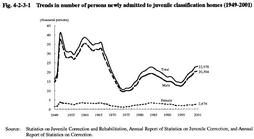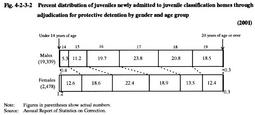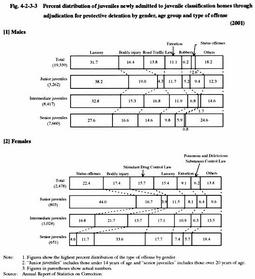| Previous Next Index Image Index Year Selection | |
|
|
2 Admission and discharge Fig. 4-2-3-1 shows the trends in the number of persons newly admitted to juvenile classification homes since 1949.
Fig. 4-2-3-1 Trends in number of persons newly admitted to juvenile classification homes (1949-2001) The number of newly admitted juveniles showed a downward trend from 1985 until 1995, only to turn upwards in 1996. In 2001, it increased by 453 (2.0%) from the previous year, reaching 22,978. This number exceeds the total number in 1984, which was the peak for the number of persons newly admitted to juveniles classification homes during the period known as the third wave of juvenile delinquency in the postwar era (see Appendix 4-10 ).Fig. 4-2-3-2 shows the percent distribution of each type of delinquency in juveniles newly admitted through adjudication for protective detention in 2001, by gender and age group. Females are more likely to be admitted at a younger age compared to males. Fig. 4-2-3-3 also shows the percent distribution of each type of delinquency in juveniles newly admitted through adjudication for protective detention in 2001, by gender. The distribution of larceny is highest for delinquent males in every age group, followed by bodily injury, extortion and status offenses for junior juveniles, Road Traffic Law violations, bodily injury and extortion for intermediate juveniles, and bodily injury, Road Traffic Law violations and extortion for senior juveniles. As regards delinquent females, status offenses had the greatest share for junior juveniles (over 40%). However, the percent distribution of status offenses committed is smaller for older age groups. For intermediate juveniles, the percent distribution of bodily injury had the greatest share, followed by larceny and status offenses. As for senior juveniles, the percentage of Stimulant Drug Control Law violations was highest. Regarding the Stimulant Drug Control Law violations, as opposed to the status offenses, as juveniles get older, the percent distribution of such violations increases remarkably. Fig. 4-2-3-2 Percent distribution of juveniles newly admitted to juvenile classification homes through adjudication for protective detention by gender and age group (2001) Fig. 4-2-3-3 Percent distribution of juveniles newly admitted to juvenile classification homes through adjudication for protective detention by gender, age group and type of offense (2001) Fig. 4-2-3-4 shows the number of persons discharged from juvenile classification homes in 2001 by reason. Probation was the most common reason for discharge from juvenile classification homes, followed by commitment to a juvenile training school, and tentative supervision. Examining the number of transfer to public prosecutor, in 2001 when the Law for Partial Amendment to the Juvenile Law, etc. was enforced, the number was 374 persons, an increase by 70 persons compared with 2000.Fig. 4-2-3-4 Number of persons discharged from juvenile classification homes by reason (2001) |



